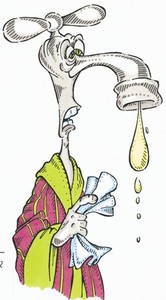Springfield Science Museum, Changing Exhibit Gallery, Second Floor
Grossology is based on a popular series of books by science teacher Sylvia Branzei. The exhibit is an interactive, larger-than-life biology lesson that harnesses children’s natural curiosity about themselves and explains how the human body functions. Grossology engages young children by appealing to their fascination with the stinky, slimy, noisy functions of their bodies.
Visitors enter Grossology by walking over a huge tongue floor mat and through a giant mouth. Once inside, they encounter Nigel Nose-It-All, a 9-foot-tall moving, talking animatronic character with a faucet-shaped head; Burp Man, a larger-than-life 3-D cartoon character that drinks from a three-foot soda can pumped by visitors; the “Patients Please” game which resembles a giant version of the popular old “Operation” game; a climbing wall where the hand- and foot-holds are warts, hair, and other blemishes on a fiberglass replica of human skin; and many other gross – but fun – activity stations.
Colorful graphics arranged throughout the exhibit provide additional interesting facts about our bodies, and children can play a multiple choice trivia game hosted by the video character “Her Grossness” to show what they have learned from visiting the exhibit.
The Grossology exhibit was created and produced by Advanced Exhibits, a division of Advanced Animations, LLC in collaboration with Science World British Columbia. Grossology is a registered trademark of Penguin Group (USA) Inc.
$4 per person special exhibit fee for all visitors ages 3 and up.
Sponsored by MassMutual Financial Group, Baystate Children’s Hospital, and the Irene E. and George A. Davis Foundation.
Related School Program: Rising to New Heights: Connecting Math and the Human Body

